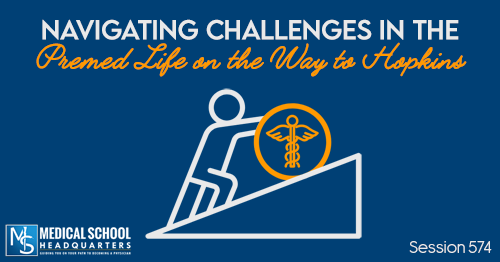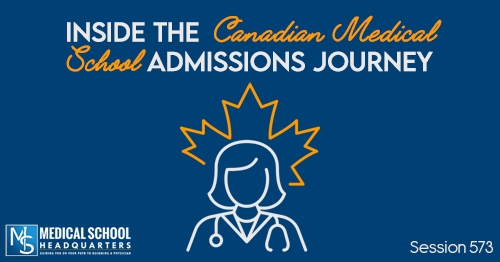Apple Podcast | Google Podcast
Session 432
Today, I break down the methodology behind the U.S. News and World Report’s rankings of medical schools. Should the rankings help you decide what medical school is good or not?
For more podcast resources to help you along your journey to medical school and beyond, check out Meded Media.
Listen to this podcast episode with the player above, or keep reading for the highlights and takeaway points.
[00:37] A Complete Baloney
The U.S. News and World Report come out with yearly best medical schools rankings. And I’m here to tell you that it is 100% complete and utter baloney. It is a useless list created to sell subscriptions to a magazine and to get clicks on a website.
'There is nothing in the US News and World Report that actually will tell you how good a medical school is for you or how well it will prepare you to be a good physician.'Click To TweetAnd so, today, we’re going to break down the methodology because they publish the methodology of how U.S. News ranks medical schools.
[01:44] The MCAT Minute
If you are planning on taking the MCAT anytime around May, June, July, it’s best to take it in March or April so you get your score back before you apply. That’s the best-case scenario.
Unfortunately, this doesn’t work for everyone. And if you need to take it in June and July because that’s when you will be most prepared, then take it. Just make sure you’re also preparing your application and turning your application in as soon as possible even before you take the MCAT.
In most cases, you can submit your application without an MCAT score submitted to one school. That way, your application will be submitted to AMCAS, AACOMAS, or TMDSAS. It will be verified by the application services, then it will go to the medical schools and they will wait for your MCAT score.
Even if you already have an MCAT score, they will still wait for your new MCAT score if you have to take it a little bit later. Most medical schools aren’t looking at applications until mid-July through late July anyway. It’s not ideal, but if you have to take it a little bit later then that is okay.
This section is sponsored by Blueprint MCAT.
If you’re looking for a great alternative to an in-person MCAT class which most people aren’t offering anymore because of the pandemic, go check out Blueprint’s new live online course with 16 amazingly structured classes that you can reschedule at any time because life happens. Go and retake them.
This is offered by two MCAT instructors who have both scored 519 or plus on their MCAT. Not only are they smart, but they can teach you different strategies.
[03:54] What Really Prepares You to Be an Amazing Physician
A lot of pre-meds are wrapped up in the fact that there are tiers of medical schools, and they will list and talk about why they’re going to a top 20 Medical School. But that’s only according to U.S. News and World Report.
People love to categorize and make sure everything fits into pretty little buckets. But it doesn’t work that way for medical schools. You can be a DO and go beyond faculty at any prestigious university in this country.
“Your ability to be an amazing physician, a great specialist, whatever you choose to do, is predicated on you and you alone, not where you went to school.”Click To TweetMedical school prepares you to be a good resident. Residency prepares you to be a great physician. And fellowship prepares you to be a great specialist. At the end of the day, where you practice and what you do in your career has almost zero bearings in terms of where you went to medical school.
Let’s use the football analogy. There are amazing college football programs out there. But go look at a professional football team roster – they are players from a spattering of Division 1, Division 2, and even Division 3 teams. It’s the individual that makes all the difference. And it’s the same for medical schools.
[07:39] Quality Assessment
The U.S. News and World Reports don’t look at the quality of education at all. So they have this quality assessment as the main thing weighted by 0.30 for the research medical school model and 0.40 for the primary care medical school model.
The different scores are confusing first of all. Most students match into primary care because that’s the most number of medical residency spots.
Then they have this quality assessment which is the quality of medical schools. For me, quality means how recent their curriculum update, match list, passing rates for Step 1 and Step 2, and of course, the Step 1 and 2 scores.
But quality for the U.S. News and World Report is a popularity contest. They have what’s called a “peer assessment score.”
[09:18] On the Basis of Subjectivity
The report says that in the fall of 2019, medical and osteopathic school deans of academic affairs and heads of internal medicine or director of admissions were asked to rate programs on a scale of 1 to 5 (1 as marginal and 5 as outstanding).
Okay, first of all, they separated medical and osteopathic when osteopathic is still medical. And to those individuals who did not know enough about a school to evaluate it, they were asked to mark “don’t know.” That’s completely subjective and it has nothing to do with the quality of a school.
Now, respondents were asked to rate program quality for both research and primary care programs separately on a single survey instrument. And only 30% of those surveyed responded.
[10:44] Assessment Score by Residency Directors
The other half of quality assessment is assessment score by residency directors in the fall of 2019. Directors were also asked to rate programs using the same five-point scale on two separate survey instruments.
One survey dealt with research and was sent to a sample of residency program directors and fields outside of primary care, including surgery, psychiatry, and radiology.
First of all, it’s asinine how they separate these suggesting there’s no research in primary care. The other survey was that primary care was sent to residency directors designated by schools as mainly involved in the primary care fields of Family Medicine, pediatrics, and internal medicine. Survey recipients were asked to rate programs on a scale of one to five.
Residency program directors were ranking medical schools. But residency program directors have no idea about medical schools other than the residents who come from those medical schools.
'Residency program directors have no idea about medical schools other than the residents who come from those medical schools.'Click To TweetJust because you like Johnny from the University of Florida medical school, doesn’t mean the University of Florida medical school is a great medical school. You cannot evaluate it based on that. That one person isn’t the whole school.
I wonder if these residency program directors know the curriculum of the medical school or what mental health programs they have. What kind of support do they have for students who fail a class? And so, point 0.30 is the weight for that for research medicals was 0.40 is the weight for primary care medical school models.
[13:01] What Research Activity?
The report also says there’s 0.40 in the research medical school model only and not used in the primary care medical school ranking model. Again, what the heck is a primary care medical school ranking? What is that model?
So it’s total NIH research activity and average NIH research activity per faculty member. It’s basically the same number. One is divided by faculty members and the other is not. Why do we need both of those when it’s the same number?
Anyway, it says this is measured by the total dollar amount of NIH research grants awarded to the medical school and its affiliated hospitals’ average for 2018 and 2019. Now, why are affiliated hospitals included in this data?
The affiliated hospital may be amazing at getting research. But what does that have to do with the quality of education at the medical school? It doesn’t have anything to do with the quality of the education you’re going to get at the medical school. It may open up opportunities if there is research you’re interested in. But you have to go seek out those opportunities.
NIH dollars have nothing to do with the quality of education at the school.
[15:11] Primary Care Model
Then they have a primary care rate for the primary care model. And it talks about the percentage of a school’s MD or DO graduates entering primary care residency is in the fields of family practice pediatrics and internal medicine that averaged over 2017, 2018, and 2019. Most medical students match into primary care because that’s where most of the residency positions are.
Just because more people going into primary care doesn’t make you a better school. Most students go into primary care and a lot of students go into internal medicine so they can later sub-specialize. But that has nothing to do with how good the medical school is.
[16:40] Student Selectivity
In this methodology, your median MCAT total score is ranked and your undergraduate GPA is ranked. According to U.S. News and World Report, if a school has a higher median MCAT score and a higher median undergraduate GPA, they are considered better schools.
Just because you did well on the MCAT and undergrad doesn’t make the medical school good. What this does instead is perverting the system. The deans of the medical schools could put pressure on the admissions committees to only accept students with really high stats so they can rank higher.
It perverts the whole system and continues to disadvantage the students who aren’t doing well on the MCAT. When the reason for that is they may not have the financial resources to put towards practice tests, tutoring, and courses.
'It's a perverted system that continues to put pressure on schools to have higher MCAT, higher GPA so that they can look better to U.S. News and Report.'Click To TweetSo there is a perverted benefit for having schools not screen secondary applications so they can be ranked higher in the report because they can say they have a low acceptance rate.
Interestingly, they said they used a logarithmic transformation of the original value for the faculty-student ratio since it had a skewed distribution. And this completely lowers the power of this.
[21:05] Stop Using This List!
Again, all of this data has nothing to do with how good of a medical school it is. Stop using this list and stop ranking your schools and picking schools based on this list. It is a complete waste of time. It has zero effect on your ability to be an amazing physician.












